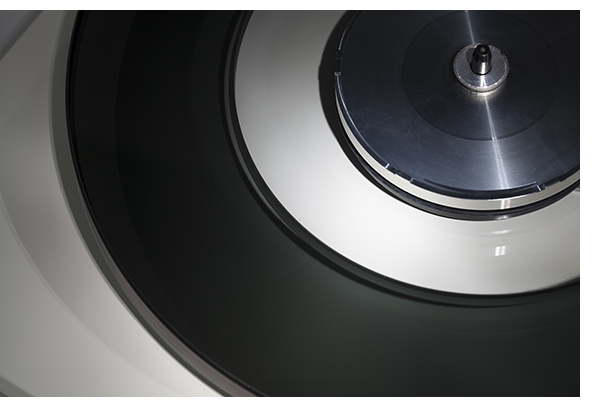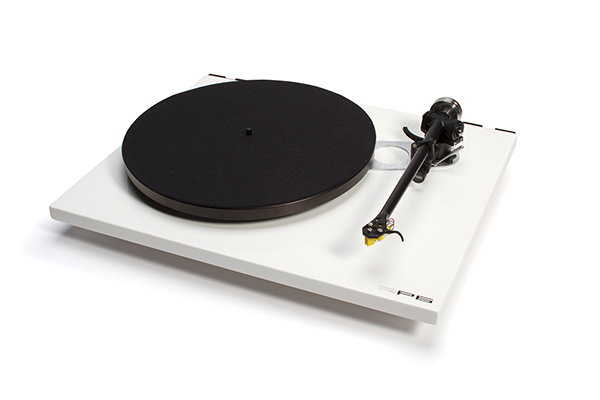Rega RP6
One of my close friends used to say, “Dude, why do you have a Rega? You can’t tweak the hell out of it.” To which my response was always, “Dude, I don’t want to tweak it. I want to listen to music.”
Years later, I maintain the same party line. If you want to enjoy your records and don’t want to get involved with the dark side of analog, acquire the Rega RP6/Exact combination. And throw your own party.
Indeed, the RP6 ups the ante on what’s possible from a $1,500 turntable. Lacking the large, wood surround from the prior P5 model, the RP6 resembles the RP3. Surveying the RP6 reveals a high-gloss MDF plinth, the same dustcover from past Rega ‘tables, and a glass platter. Careful inspection leads to quite a bit more.
Adding a pre-installed Rega Exact (MM) cartridge increases the price to $1,990, a $100 savings over buying such items separately. It also drops set-up time to under five minutes. If you are an analog apprentice, you may not fully appreciate just how painless this solution is, but if you are stepping up from another ‘table, it doesn’t get any easier. My advice: Resist the urge to diddle with the settings and rock out. While my analog madness is beyond cure, I can appreciate the superb performance and simplicity offered by the Rega range. The P3 has been part of my system since 1983, and the P9 since 2006. If you want analog excellence without the fuss—this is the way to roll (or spin).
What’s New?
Rega is all about refinement. Don’t expect to be hit over the head by the RP6. Rather than manufacture a wide range of different turntables with myriad approaches to design, Rega fine-tunes its basic model when going up the range—or, depending on your view, provides a more cost-effective version of its top-of-the-line deck. The result is a bigger, weightier sound, with the ability to extract finer detail from recordings with each step up the ladder.
The RP6 shares the same RB303 tonearm with the RP3 and, while the plinth on both ‘tables looks identical, the one on the RP6 is distinctive, claiming additional CNC machining to further lower its mass. The new model also takes advantage of the more sophisticated feet from Rega’s premier P9 turntable in order to reduce the amount of vibration reaching the platter.
An external TT-PSU, an optional accessory on the RP3 that adds $395 to its price, is standard on the RP6. It provides better speed stability and the ability to change between 33.3 and 45RPM speeds with the push of a button instead of having to remove the platter and belt. In addition to an upgraded circuit design, the new power supply also features enhanced aesthetics that adhere to the look of the current Brio-R, Apollo-R, and DAC. It works in concert with the new 24-volt motor, hand-tuned on each ‘table before final assembly. On the test bench, said refinement dramatically lowers the amount of vibration that the motor passes onto the plinth, reducing the noise floor while increasing the amount of low-level information you hear on the couch.
 While the RP6 uses the same double-brace technology, making for a more rigid mechanical connection between the tonearm base and main-bearing housing, the subplatter cap is now machined—as opposed to the all-plastic part on the RP3. This process gives Rega’s new platter a perfectly flat surface on which to rest, again making for a better physical connection between record surface and platter. The platter features two pieces of glass that are bonded together with a UV cured glue instead of the single piece that Rega has used for years and is very labor intensive to produce. The second piece is a ring, adding more mass at the outside of the spinning platter where it will do the most good. Very clever.
While the RP6 uses the same double-brace technology, making for a more rigid mechanical connection between the tonearm base and main-bearing housing, the subplatter cap is now machined—as opposed to the all-plastic part on the RP3. This process gives Rega’s new platter a perfectly flat surface on which to rest, again making for a better physical connection between record surface and platter. The platter features two pieces of glass that are bonded together with a UV cured glue instead of the single piece that Rega has used for years and is very labor intensive to produce. The second piece is a ring, adding more mass at the outside of the spinning platter where it will do the most good. Very clever.
More Rega-like
A side-by-side comparison to our RP3/TT-PSU with the Exact cartridge immediately exposes the RP6’s intensified performance. “Dog to Bone,” from Spoek Mathambo’s Father Creeper, yields a deeper and more cohesive groove. The RP3 gets the fundamentals, but the RP6 lays into the bass texture. The major grooves in SBTRKT’s self-titled album divulge the same; the cavernous beats possess a wetter, more sinewy quality through the RP6.
Both the new Audio Research REF Phono 2SE and Monk Audio phonostages illustrate the RP6’s greater microdyamic ability and tonal contrast, confirming that the model’s more sophisticated approach delivers more music. Remember, Rega is about evolution, not revolution. The RP3 isn’t crapola now that the RP6 is out, and the latter doesn’t annihilate the RP3. Instead, the RP6 builds on the strengths of the RP3. If you have a small room and small speakers that lack serious low-frequency extension, the RP3 may well be a great place to hang your hat. However, if your system has good low-frequency capability, you’ll notice the extra authority the RP6 musters.
As for the midrange? Ditto. On Crowded House’s “You Better Be Home Soon,” the organ comes further out of the densely packed mix and vocal harmonies showcase extra contrast. George Martin/Geoff Emerick’s production of Cheap Trick’s All Shook Up epitomizes this jump factor and dynamic extension. The opening track’s percussion leaps out of the speakers, and plenty of punch accompanies Bun E. Carlos’ thunderous drumming. The recording’s Beatlesque layers are expanded with a precision that neither the RP3 nor my mid vintage LP-12 summon.
Plug and Play, or Move On
Rega’s US importer, Steve Daniels of The Sound Organisation, likes to say that the Exact “sounds as much like an MC can while still being a MM.” The more time I spend with the Exact, the more I agree. The cartridge reproduces delicate, low-level signals with ease, yet manages wide dynamic swings. Via Classic Records’ Led Zeppelin reissues, the RP6/Exact combination renders a wide tonal landscape, with the necessary weight that do the albums justice.
While the Exact is an excellent plug-and-play solution for the RP6, the RB303 tonearm is capable of even more, should you decide to go further upmarket with a cartridge. While some might argue that such a move is pointless since the RP6 shares the same tonearm as the lower-priced RP3, the RP6’s advanced design allows a higher signal-to-noise ratio, permitting the RB303 to take better advantage of a premium cartridge.
A few usual suspects that make perfect sense for an upgrade from the Exact all turn in great performances. The Dynavector 17D3 ($1,000), Sumiko Blackbird ($1,100), and Rega’s own Apheta ($1,795) extract more music without penalty. The Lyra Kleos ($2,995) also works well, but it’s overkill; the model does not give its top performance in this setting. If you keep any cartridge upgrade to about $1,000, you will be rewarded with an appropriate measure of performance. Use spendier cartridges with the P7 and P9.
Both the RP3 and RP6 are moving closer to the sound of the flagship P9, incorporating the speed and imaging prowess that have made Rega decks famous, and boasting a more robust bottom end. It all has me wondering what an RP9 will sound like should Rega make similar updates to it.
 Rega RP6 Turntable
Rega RP6 Turntable
MSRP: $1,495 (turntable only); $1,990 (with Rega Exact cartridge)
Manufacturer: www.rega.co.uk
US Importer: www.soundorg.com
Peripherals
Preamplifier ARC REF 5SE
Phonostage ARC REF Phono 2SE, Monk Audio Phonostage
Power Amplifier ARC REF 150
Speakers Dynaudio Confidence C1



